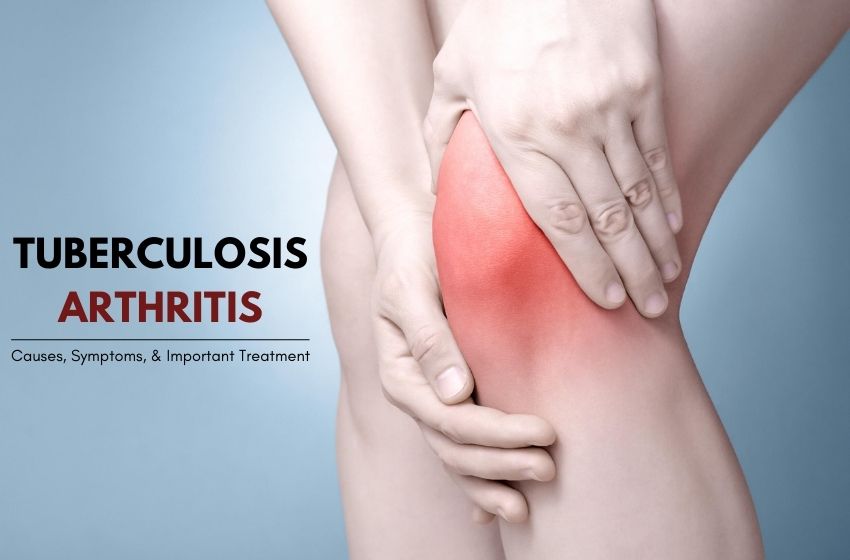
Tuberculosis Arthritis: Causes, Symptoms, & Important Treatment You Should Know
- Lifestyle Health
 Alessia Braun
Alessia Braun- March 24, 2022
- 0
- 10 minutes read
Tuberculosis which is commonly known as TB prevails to be among the major issues for healthcare workers. The amount of reported cases of extrapulmonary tuberculosis, mainly osteoarticular tuberculosis, is growing with each passing day. On this World Tuberculosis (TB) Day, we will be talking about tuberculosis arthritis.
This article will talk about what is tuberculosis arthritis, what causes this, evident symptoms, and many more. So without any further delay, let us get started with this article.
What Is Tuberculosis Arthritis?
Tuberculosis (TB) is a chronic, exhausting disease that is caused by Mycobacterium tuberculosis, which commonly impacts the lungs once this microorganism enters the body via droplet infections. In some scenarios, however, this disease happens outside the lungs and is called extra pulmonary tuberculosis (TB). This extra pulmonary TB in the joints is called tuberculosis arthritis.
TB arthritis generally impacts large joints such as the knee and can cause serious destruction of the joints and tendon. This can also spread to the surrounding bursa, soft tissues, and muscles. However, TB arthritis must be segregated from other types of arthritis. This is limited to a single joint, and the period of swelling is also longer with this being a chronic disease and this swelling is present for six weeks or even more. Finally, a joint that is impacted by tuberculosis arthritis is not warm to touch, which is an indicator of most types of arthritis.
Causes Of Tuberculosis Arthritis
Tuberculosis arthritis is created by the bacterium, Mycobacterium tuberculosis. While the bacteria primarily impacts the lungs, a very small portion of people will develop this form of arthritis. The joints most commonly associated are:
- Ankles
- Knees
- Hips
- Spine
- Wrists
Once the bacterium gets into the lung, it may spread to a joint via the bloodstream. Initially, the synovial membrane starts to get inflamed, which is seen as swelling and pain on the affected joint. As the disease goes forward, the joint starts to lose function and becomes prone to other bacterial infections like those by Staphylococcus aureus. This secondary infection aggravates the swelling and pain and poses the risk of developing sepsis.
Risk Factors Towards Developing TB Arthritis Include:
The risks that are associated when you develop a tuberculous arthritis are:
- A pre-existing arthritis scenario such as rheumatoid arthritis and osteoarthritis
- Previous trauma of joints
- HIV/AIDS
- Joint damage because of the conditions like sickle cell disease
- Malnutrition, poor living conditions
Symptoms Of Tuberculosis Arthritis
It is crucial to note that TB arthritis hints of persistent joint swelling over a span of time, and the pain is limited to a single joint, and does not respond to antibiotics. Here are the symptoms of this disease that you should know about.
- Joint swelling, tender joints
- Low-grade fever
- Decreased joint mobility
- Muscle atrophy, muscle spasms
- Numbness, tingling sensation, or weakness below the point of infection (in the spine)
- Loss of appetite and weight loss
How To Treat Tuberculosis Arthritis?
All this while we were talking about the definition, cause, and symptoms of this disease, but that is not enough. So by now, you must have known what is tuberculous arthritis? We are not here to talk about the problem primarily. We are here to also offer you the solution and so we will see that if you are suffering from tuberculosis arthritis, how you can treat that.
Screening Test And Investigations Required To Confirm The Disorder
This is the first step of tuberculous arthritis treatment. A physical examination of the impacted joint will reveal irritation or swelling. Further diagnosis includes the following:
- Biopsy – A sample of fluid is extracted from the joint and then cultured to detect the presence of TB bacilli. Additionally, the joint tissue will show granulomas with Langhans giant cells, with or without the bacilli.
- Tuberculin skin test
- Imaging examinations – Chest x-ray, CT scan of the spine, joint x-ray, and magnetic resonance imaging (MRI) can assure the diagnosis.
Treatment Modalities
Extra-pulmonary TB is often diagnosed with the same set of antibiotics that are used to treat pulmonary TB. The drugs are required to be taken for a minimum of six months and it is crucial to take the medicines exactly as instructed and to complete the course as prescribed by the doctor.
The treatment treats the infection by fighting against the TB bacteria. An integration of drugs is used: Rifampicin, Pyrazinamide, Isoniazid, and Ethambutol. Painkillers also help to relieve the symptoms of TB arthritis, in addition to the application of heat or cold to the joints that are affected.
Surgery is at times needed to drain spinal abscesses or to stabilize the spine. It is otherwise a rare choice for infection at other sites.
Side Effects And Precautions Of Extra-pulmonary TB
There are several side effects of Extrapulmonary TB medications. So you have to be informed about them. The side effects include:
- Blurred vision
- Jaundice
- Burning pain in feet
- Aggravation and Relapse of the condition if treatment is discontinued prior to its completion; germ resistance develops creating cure difficulty.
So as a precaution you should always remember that the side effects of the medication can be prevented with a balanced, nutritious diet. It also assures good recovery from the condition.
Conclusion
Even those who get in contact with an infected person can prevent a full-blown outbreak of tuberculosis arthritis. Even though a skin test for TB (PPD) will turn positive, many people who have been in contact with the bacterium harbor an inactive infection. A preventive therapy can be discussed with the doctor. There are preventive measures for all and treatment as well. So as soon as you find out any such symptoms it is always advised to visit the doctor as soon as possible.

